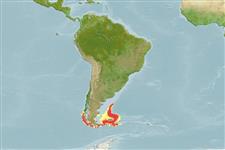Teleostei (teleosts) >
Ophidiiformes (Cusk eels) >
Bythitidae (Livebearing brotulas)
Etymology: Cataetyx: Greek, kata = down + Greek, etix, stixo, stizo = to prick, to puncture.
Eponymy: This is a toponym referring to the Messier Strait, Patagonia, Chile, where the holoype was collected. (Ref. 128868), visit book page.
More on author: Günther.
Environment: milieu / climate zone / depth range / distribution range
Ecology
Marine; bathydemersal; depth range 140 - 1649 m (Ref. 75877). Deep-water; 42°S - 57°S
Southeast Pacific and Southwest Atlantic: Patagonian region of Chile and Argentina. Records from South Africa and New Zealand are erroneous (Ref. 34024).
Size / Weight / Age
Maturity: Lm ? range ? - ? cm
Max length : 27.6 cm SL male/unsexed; (Ref. 27363)
Uncommon species (Ref. 34024).
Life cycle and mating behavior
Maturity | Reproduction | Spawning | Eggs | Fecundity | Larvae
Nielsen, J.G., D.M. Cohen, D.F. Markle and C.R. Robins, 1999. Ophidiiform fishes of the world (Order Ophidiiformes). An annotated and illustrated catalogue of pearlfishes, cusk-eels, brotulas and other ophidiiform fishes known to date. FAO Fish. Synop. 125(18):178p. Rome: FAO. (Ref. 34024)
IUCN Red List Status (Ref. 130435: Version 2024-2)
Threat to humans
Harmless
Human uses
Fisheries: of no interest
Tools
Special reports
Download XML
Internet sources
Estimates based on models
Preferred temperature (Ref.
123201): 2.9 - 6.1, mean 4.3 °C (based on 70 cells).
Phylogenetic diversity index (Ref.
82804): PD
50 = 0.5002 [Uniqueness, from 0.5 = low to 2.0 = high].
Bayesian length-weight: a=0.00447 (0.00172 - 0.01163), b=3.10 (2.87 - 3.33), in cm total length, based on LWR estimates for this (Sub)family-body shape (Ref.
93245).
Trophic level (Ref.
69278): 3.6 ±0.5 se; based on size and trophs of closest relatives
Resilience (Ref.
120179): Low, minimum population doubling time 4.5 - 14 years (Assuming Fec < 100).
Fishing Vulnerability (Ref.
59153): Low vulnerability (24 of 100).
